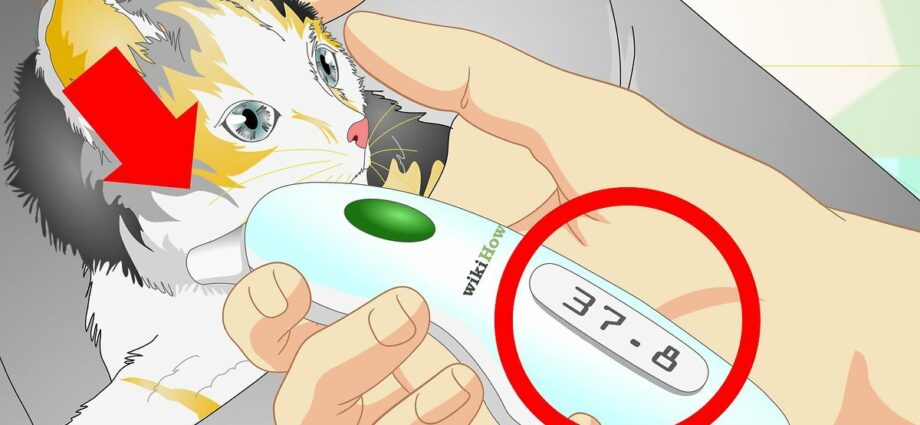Contents
Cat’s temperature: how to take it?
Has your cat been tired, downcast or eating less for some time and you suspect a fever? Do you want to take his temperature but do not know how to proceed? Very common act, essential for the examination of our animals, the temperature measurement can be carried out with a simple electronic thermometer. The temperament of some cats can quickly complicate this gesture, but here are some tips for trying to do it at home.
Why take your cat’s temperature?
The average temperature of cats is 38,5 ° C. It can vary from 37,8 ° C to 39,3 ° C in a healthy animal depending on the time of day and recent activity.
For example, a stressed cat can see its temperature rise above 39 ° C without this being abnormal. Conversely, after a nap on a cold tile, a cat’s temperature can drop below 38 ° C. The temperature remains however an essential parameter to evaluate the state of health of a cat and variations outside these average values must be monitored.
Temperature abnormalities will often manifest as a change in the cat’s attitude and a drop in general condition:
- prostration ;
- decreased appetite;
- fatigue or weakness;
- lethargy;
- etc.
These signs can appear as much in case of:
- hyperthermia (increased body temperature or fever);
- hypothermia (drop in temperature).
Depending on the situation, the cat may also be looking for a cool or warm place to compensate for the variation in its body temperature.
Many pathologies can create fever in cats, but infectious causes are the most common. Whether it is a localized infection (abscess, infected wounds) or general. The hypothermia are often due to chronic pathologies in course of evolution or to a serious attack of the general condition.
If your cat’s behavior alerts you to the aforementioned signs, you can definitely try to take his temperature at home to get additional information on his state of health. Yes, although it is less easy than with dogs, it is possible, with a little patience, calm and technique.
How to take your cat’s temperature?
Frontal or ear-type human thermometers are not for use in animals. This is because the hairs prevent a correct measurement and the temperature of the ears is not indicative of the body temperature.
The most reliable measurement is therefore taken rectally. An electronic thermometer should then be used, if possible with a flexible tip and quick-setting. These types of thermometers are available from pharmacies and are often pediatric models. Also prepare a towel or large cloth that can allow you to gently wrap the cat for handling.
First, place yourself in a calm and non-stressful environment for the cat. It is easier and safer to do this act together to share the tasks. One person will just hold the cat and the second will only take the temperature. Do not hesitate to gently wrap the cat in a towel to maintain it well and protect itself from potential scratches. Also use your voice, caresses and why not sweets to entertain and reassure him during this moment which is not very pleasant for him.
First, put petroleum jelly on the tip of the thermometer. Gently lift the cat’s tail by the base and slide the thermometer tip into its anus. A depth of 2 cm is often sufficient.
The measurement is generally carried out in about ten seconds and an audible signal is emitted by the thermometer. You can remove the thermometer and read the temperature displayed on the screen.
Consider rewarding kitty for her patience and cooperation with hugs and treats.
Remember to clean the thermometer with a suitable disinfectant according to its instructions for use.
How to interpret the result?
The measured temperature is outside normal values (fever or hypothermia)
Contact your veterinarian and explain the situation to them. Depending on the general condition of the cat and the signs you report, it will tell you if a consultation is necessary and the degree of urgency. Be careful, during improper handling, the thermometer may display a low temperature if the thermometer tip was not deep enough or if the setting was too fast.
The measured temperature is within the normal values
Good news, your cat has a normal temperature. Unfortunately, this is not enough to rule out disease. If you are still seeing any abnormal signs in your cat’s behavior and general condition, the best thing to do is to contact your veterinarian to discuss them.
If you can’t take your cat’s temperature because she’s too agitated or you’re not sure how to do it, don’t be persistent. Do not take the risk of hurting yourself or your pet for this information. If you wish, your veterinarian can show you how to do this at your next consultation.
In the slightest doubt and for all cases, contact your veterinarian who will be able to advise you effectively according to the situation and the needs of your cat.










